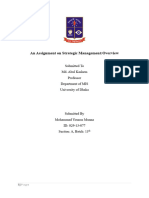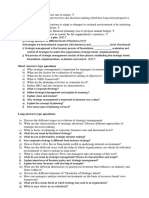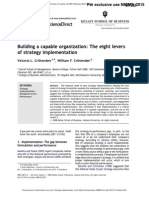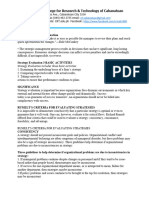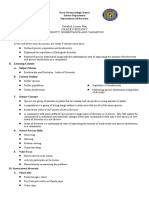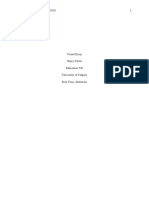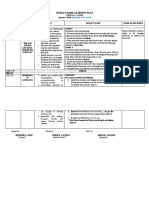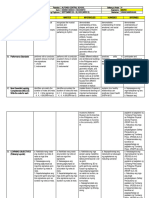David Tif 09
David Tif 09
Uploaded by
aslanozbay33Copyright
Available Formats
Share this document
Did you find this document useful?
Is this content inappropriate?
Report this DocumentCopyright:
Available Formats
David Tif 09
David Tif 09
Uploaded by
aslanozbay33Copyright:
Available Formats
Chapter 9: Strategy Review, Evaluation, and Control
CHAPTER 9
Strategy Review, Evaluation, and Control
True/False
The Nature of Strategy Evaluation
1. Most strategists believe that an organization’s well being depends on evaluation
of the strategic-management process.
(t; easy; p. 298)
2. Adequate, timely feedback is important to effective strategy evaluation.
(t; easy; p. 298)
3. Too much emphasis on evaluating strategies may be expensive and
counterproductive.
(t; medium; p. 298)
4. Strategy evaluation should have a long-run focus and avoid a short-run focus.
(f; medium; p. 299)
5. According to Richard Rumelt, consonance and consistency are based on a firm’s
external assessment.
(f; medium; p. 299)
6. According to Rumelt, consistency and feasibility are largely based on a firm’s
internal assessment.
(t; medium; p. 299)
7. Consistency, distinctiveness, advantage and feasibility are Richard Rumelt’s four
criteria for evaluating a strategy.
(f; medium; p. 299)
460
Copyright © 2009 Pearson Education, Inc. Publishing as Prentice Hall
Chapter 9: Strategy Review, Evaluation, and Control
8. Strategy evaluation is becoming increasingly easier with the passage of time,
given the technological advances.
(f; difficult; p. 300; AACSB: Reflective thinking skills)
9. The decreasing time span for which planning can be done with any degree of
certainty is a reason strategy evaluation is more difficult today.
(t; medium; p. 300; AACSB: Reflective thinking skills)
10. Strategies may be inconsistent if policy problems and issues continue to be
brought to the top for resolution.
(t; easy; p. 300)
11. Competitive advantages normally are the result of superiority in one of three
areas: feasibility, consistency, or consonance.
(f; medium; p. 300; AACSB: Reflective thinking skills)
12. Regardless of the size of the organization, a certain amount of management by
wandering around at all levels is essential to effective strategy evaluation.
(t; medium; p. 301)
13. Because large companies have more at stake, it is more important for large
organizations to conduct strategy evaluation than small companies.
(f; easy; p. 301)
14. The end of the fiscal year is the best time to do strategy evaluation.
(f; medium; p. 301; AACSB: Reflective thinking skills)
A Strategy-Evaluation Framework
15. Changes in the organization’s management, marketing, finance, R&D and CIS
strengths and weaknesses should all be the focus of a revised EFE matrix in
strategy evaluation.
(f; medium; p. 300; AACSB: Analytic skills)
16. In strategy evaluation, a revised IFE matrix should indicate how effective a firm’s
strategies have been in response to key opportunities and threats.
(f; medium; p. 302; AACSB: Reflective thinking skills)
461
Copyright © 2009 Pearson Education, Inc. Publishing as Prentice Hall
Chapter 9: Strategy Review, Evaluation, and Control
17. Strengths, weaknesses, opportunities and threats should continually be monitored
for change because it is not really a question of whether these factors will change
but rather when they will change and in what ways.
(t; medium; p. 302)
18. When taking corrective action, you need to compare expected results to actual
results.
(f; easy; p. 302)
19. Criteria for evaluating strategies should be measurable and easily verifiable.
(t; easy; p. 302)
20. Specific financial ratios are rarely used criteria to evaluate strategies.
(f; medium; p. 302)
21. Measuring organizational performance includes comparing expected results to
actual results, investigating deviations from plans, evaluating individual
performance and examining progress being made toward meeting stated
objectives.
(t; medium; p. 304; AACSB: Reflective thinking skills)
22. Intuitive judgments are almost always involved in deriving quantitative criteria.
(t; medium; p. 304)
23. Most quantitative evaluation criteria are geared to long-term objectives rather than
annual objectives.
(f; medium; p. 304; AACSB: Analytic skills)
24. Measuring organizational performance requires making changes to reposition a
firm competitively for the future.
(f; medium; p. 304)
25. Taking corrective actions does not necessarily mean that existing strategies will
be abandoned, or even that new strategies must be formulated.
(t; medium; p. 305)
462
Copyright © 2009 Pearson Education, Inc. Publishing as Prentice Hall
Chapter 9: Strategy Review, Evaluation, and Control
26. Corrective action in strategy evaluation is necessary to keep an organization on
track toward achieving stated objectives.
(t; easy; p. 305)
27. Alvin Toffler argues that environments are becoming so dynamic and complex
that they threaten people and organizations with future shock in his thought-
provoking books entitled Future Shock and The Third Wave.
(t; medium; p. 305; AACSB: Reflective thinking skills)
28. Future shock occurs when the type and speed of changes overpower an individual
or organization’s ability and capacity to adapt.
(t; medium; p. 305)
29. According to research, participation in strategy-evaluation activities is one of the
best ways to overcome individuals’ resistance to change.
(t; medium; p. 305)
The Balanced Scorecard
30. The basic form of a Balanced Scorecard is the same for all organizations and
industries.
(f; easy; p. 306)
31. The Balanced Scorecard Approach deals with the question, “How satisfied are the
firm’s customers.”
(t; medium; p. 306)
Published Sources of Strategy-Evaluation Information
32. Each year, Fortune publishes strategy evaluation research on both the United
States and other countries.
(t; medium; p. 306)
33. The most admired company in the world in 2007 was Apple.
(f; medium; p. 308)
463
Copyright © 2009 Pearson Education, Inc. Publishing as Prentice Hall
Chapter 9: Strategy Review, Evaluation, and Control
Characteristics of an Effective Evaluation System
34. Strategy-evaluation activities must be meaningful, i.e., they should specifically
relate to a firm’s objectives.
(t; medium; p. 308)
35. Timely approximate information is generally more desirable as a basis for
strategy evaluation than accurate information that does not depict the present.
(t; easy; p. 308)
36. The test of an effective evaluation system is its usefulness and complexity.
(f; medium; p. 308)
37. Small organizations require a more elaborate and detailed strategy-evaluation
system because they are still evolving.
(f; medium; p. 308; AACSB: Reflective thinking skills)
38. There is no one ideal strategy-evaluation system for all organizations.
(t; easy; p. 309)
Contingency Planning
39. Contingency plans are alternative plans that can be put into effect if certain key
events do not occur as expected.
(t; medium; p. 309)
40. Organizations should prepare contingency plans just for unfavorable events.
(f; difficult; p. 309)
41. Strategies should try to cover all bases by planning for all possible contingencies.
(f; medium; p. 309)
42. Contingency plans should be as simple as possible.
(t; easy; p. 309)
464
Copyright © 2009 Pearson Education, Inc. Publishing as Prentice Hall
Chapter 9: Strategy Review, Evaluation, and Control
43. Alternative strategies not selected for implementation should be discarded, as they
have a tendency to contaminate the contingency plans.
(f; medium; p. 298; AACSB: Reflective thinking skills)
44. Identifying both beneficial and unfavorable events that could possibly derail the
strategy or strategies is the first step of effective contingency planning.
(t; medium; p. 311)
Auditing
45. Independent auditors, government auditors and IRS auditors are the three groups
of people who perform audits.
(f; medium; p. 311)
46. Independent auditors are basically CPAs who provide their services to
organizations for a fee.
(t; easy; p. 311)
47. Public accounting firms usually avoid strategy evaluation services.
(f; medium; p. 312)
48. China is home to 16 of the world’s 20 most polluted cities.
(t; easy; p. 312; AACSB: Multicultural and diversity understanding)
49. Over 90 percent of China’s energy is derived from solar and nuclear power.
(t; medium; p. 313; AACSB: Multicultural and diversity understanding)
50. Two government agencies—IRS and GAO—employ government auditors
responsible for making sure organizations comply with federal laws, statutes and
policies.
(t; medium; p. 312)
51. Moving environmental affairs from the line side of the organization to the staff
side is required when instituting an environmental audit.
(f; difficult; p. 312; AACSB: Ethical understanding and reasoning abilities)
465
Copyright © 2009 Pearson Education, Inc. Publishing as Prentice Hall
Chapter 9: Strategy Review, Evaluation, and Control
52. The strategic management process should be completely open because
participation and openness enhance understanding, commitment, and
communication within the firm.
(t; easy; p. 314)
53. Increased education and diversity of the workforce at all levels are reasons why
the top-down approach should be favored in organizations.
(f; medium; p. 315; AACSB: Multicultural and diversity understanding)
Multiple Choice
The Nature of Strategy Evaluation
54. Which of these is/are a basic activity of strategy evaluation?
a. Reviewing the underlying internal and external factors that represent the
bases of current strategies
b. Measuring organizational performance
c. Taking corrective actions
d. all of the above
e. both B and C
(d; easy; p. 298)
55. The purpose of strategy evaluation is to
a. increase the budget annually.
b. alert management to problems or potential problems.
c. make budget changes.
d. evaluate employees’ performance.
e. improve R&D programs.
(b; medium; p. 298)
56. What is the cornerstone of effective strategy evaluation?
a. Adequate and timely feedback
b. Quality and quantity of managers
c. Smaller ratio of top- to lower-level management
d. Evaluation preceding implementation stage
e. Taking corrective actions
(a; difficult; p. 298)
466
Copyright © 2009 Pearson Education, Inc. Publishing as Prentice Hall
Chapter 9: Strategy Review, Evaluation, and Control
57. All of these are Richard Rumelt’s criteria to evaluate a strategy except:
a. advantage.
b. consistency.
c. feasibility.
d. distinctiveness.
e. consonance.
(d; medium; p. 299)
58. What is happening to strategy evaluation with the passage of time?
a. increasingly difficult
b. much simpler
c. very convenient
d. an unnecessary activity
e. less important
(a; medium; p. 300)
59. All of the following are reasons strategy evaluation is more difficult today except:
a. a dramatic increase in the environment’s complexity.
b. the increasing number of variables.
c. the increase in the number of both domestic and world events affecting
organizations.
d. the decreasing difficulty of predicting the future with accuracy.
e. the rapid rate of obsolescence of even the best plans.
(d; easy; p. 300)
60. Which of the following is not a reason for the increasing difficulty of evaluating
strategies?
a. Product life cycles are longer today than ever.
b. Domestic and world economies are less stable than ever.
c. Product development cycles are longer than ever.
d. Technological advancement is more rapid.
e. Change is occurring more frequently than ever.
(a; medium; p. 300)
467
Copyright © 2009 Pearson Education, Inc. Publishing as Prentice Hall
Chapter 9: Strategy Review, Evaluation, and Control
61. What is important because organizations face dynamic environments in which key
external and internal factors often change quickly and dramatically?
a. Strategy formulation
b. Strategy evaluation
c. Strategy simplification
d. Strategy modification
e. Strategy implementation
(b; medium; p. 299; AACSB: Reflective thinking skills)
62. A final broad test of strategy is its
a. advantage.
b. feasibility.
c. consonance.
d. consistency.
e. distinctiveness.
(b; medium; p. 299)
63. Competitive advantage normally is the result of superiority in resources, skills and
a. employees.
b. position.
c. consistency.
d. feasibility.
e. governance.
(b; easy; p. 299)
64. What term refers to the need for strategists to examine sets of trends, as well as
individual trends in evaluating strategies?
a. Consistency
b. Consonance
c. Synergy
d. Feasibility
e. Advantage
(b; medium; p. 299)
468
Copyright © 2009 Pearson Education, Inc. Publishing as Prentice Hall
Chapter 9: Strategy Review, Evaluation, and Control
65. In evaluating strategies, which one of Rumelt’s criteria for evaluating strategies,
refers to the need for strategists to examine sets of trends?
a. consistency
b. consonance
c. feasibility
d. advantage
e. empowerment
(b; medium; p. 299; AACSB: Reflective thinking skills)
66. If success for one organizational department means failure for another
department, then strategies may be
a. synergistic.
b. advantageous.
c. inconsonant
d. failures.
e. inconsistent.
(e; easy; p. 301)
67. When empowered employees are held accountable for and pressured to achieve
specific goals and are given wide latitude in their actions to achieve them, there
can be
a. increased productivity.
b. dysfunctional behavior.
c. decreased number of complaints.
d. decreased turnover.
e. increased number of litigations.
(b; medium; p. 301)
68. Strategy-evaluation activities should be performed
a. on a periodic basis.
b. at the onset of a problem.
c. on a continuous basis.
d. upon completion of major projects.
e. every two years.
(c; easy; p. 301)
469
Copyright © 2009 Pearson Education, Inc. Publishing as Prentice Hall
Chapter 9: Strategy Review, Evaluation, and Control
A Strategy-Evaluation Framework
69. Corrective actions are not needed when
a. changes have occurred in the firm’s internal strategic position.
b. external and internal factors have not significantly changed.
c. the firm is not progressing satisfactorily toward achieving stated
objectives.
d. competitive factors are on the rise.
e. the industry is slowing down.
(b; medium; p. 302)
70. When you discover major changes have occurred in the firm’s internal strategic
position while conducting strategy evaluation, you should
a. continue on the present strategic course.
b. immediately discontinue all aspects of the present strategic course.
c. take corrective actions.
d. add additional funds to the present strategic plan.
e. copy the actions of major competitors.
(c; difficult; p. 302; AACSB: Reflective thinking skills)
71. Changes in the organization’s management, marketing, finance/accounting, R&D
and CIS strengths and weaknesses should be the focus of a revised
a. mission.
b. IFE matrix.
c. vision.
d. EFE matrix.
e. EPM matrix.
(b; medium; p. 302; AACSB: Reflective thinking skills)
72. A revised __________ should indicate how effective a firm’s strategies have been
in response to key opportunities and threats.
a. IFE matrix
b. mission
c. EFE matrix
d. vision
e. CPM matrix
(c; medium; p. 302)
470
Copyright © 2009 Pearson Education, Inc. Publishing as Prentice Hall
Chapter 9: Strategy Review, Evaluation, and Control
73. Which of the following is not included in measuring organizational performance?
a. Comparing results to competitors’ expectations.
b. Examining progress being made toward meeting stated objectives.
c. Investigating deviations from plans.
d. Evaluating individual performance.
e. Comparing expected results to actual results.
(a; medium; p. 304)
74. Ineffectiveness and/or inefficiencies indicate the need for
a. layoffs.
b. consultants.
c. some form of correction action.
d. reductions in pay.
e. more synergy.
(c; medium; p. 304)
75. What is the basis for quantitative financial evaluation?
a. Reduction in costs
b. The EPS/EBIT Analysis
c. Capital Asset Pricing Model
d. Financial ratios
e. Present value analysis
(d; medium; p. 304; AACSB: Analytic skills)
76. Which of these is not a key financial ratio?
a. Market share
b. Production quality
c. Earnings per share
d. Asset growth
e. Return on equity
(b; medium; p. 304; AACSB: Analytic skills)
77. Strategy evaluation is based on
a. empirical data.
b. qualitative criteria.
c. objective data.
d. qualitative and quantitative criteria.
e. intuition.
(d; medium; p. 304)
471
Copyright © 2009 Pearson Education, Inc. Publishing as Prentice Hall
Chapter 9: Strategy Review, Evaluation, and Control
78. Financial ratios are used to compare a firm’s performance over different time
periods, compare the firm’s performance to industry averages, and compare a
firm’s performance with
a. overall business standards.
b. the performance of international firms.
c. the performance of suppliers.
d. non-financial ratios.
e. the performance of competitors.
(e; difficult; p. 304; AACSB: Analytic skills)
79. Most quantitative criteria are geared to objectives rather than
objectives.
a. top-management; employee
b. short-term; annual
c. annual; long-term
d. environmental; community
e. profit; social
(c; medium; p. 304)
80. What corrective actions should a firm take during strategy evaluation?
a. Revising the business mission
b. Issuing stock
c. Revising objectives
d. Selling a division
e. all of the above
(e; medium; p. 305)
81. What occurs when the nature, types and speed of changes overpower an
individual’s or organization’s ability and capacity to adapt?
a. Corporate downfall
b. Corrective actions
c. Future shock
d. Corporate agility
e. Measuring performance
(c; medium; p. 305; AACSB: Reflective thinking skills)
472
Copyright © 2009 Pearson Education, Inc. Publishing as Prentice Hall
Chapter 9: Strategy Review, Evaluation, and Control
82. Corrective actions should
a. strengthen an organization’s competitive position in its industry.
b. streamline asset holdings.
c. reduce the staff size.
d. involve abandoning existing strategies.
e. all of the above
(a; medium; p. 305)
83. What is the best way to overcome individuals’ resistance to change in strategy
evaluation?
a. Participation
b. Command-and-control
c. Laissez-faire system
d. Rational argument
e. Emotional reactions
(a; medium; p. 305)
84. An organization’s ability to adapt successfully to changing circumstances refers to
its
a. corporate agility.
b. future shock.
c. dynamism.
d. revision power.
e. liquidity.
(a; easy; p. 305)
85. Corrective action should do all of the following except:
a. capitalize upon internal strengths.
b. avoid external opportunities.
c. avoid external threats.
d. improve internal weaknesses.
e. strengthen an organization’s competitive position.
(b; medium; p. 305)
473
Copyright © 2009 Pearson Education, Inc. Publishing as Prentice Hall
Chapter 9: Strategy Review, Evaluation, and Control
The Balanced Scorecard
86. Which of the following is not a component of the Balanced Scorecard?
a. Social responsibility
b. Financial performance
c. Customer knowledge
d. Internal business processes
e. Learning and growth
(a; medium; p. 306)
87. What aims to balance long term with short term concerns, financial with non-
financial concerns, and internal with external concerns.
a. Contingency planning
b. The Balanced Scorecard approach
c. Taking corrective action
d. Measuring performance
e. reviewing Bases of Strategy
(b; medium; p. 306)
Published Sources of Strategy-Evaluation Information
88. In the important publication used to evaluate a firm’s strategy, the Fortune 50
includes all of the following except:
a. the top retailers.
b. the top transportation companies.
c. the top utilities.
d. the top banks.
e. the top hospitals.
(e; medium; p. 306)
89. Which of these is not a key attribute in Fortune’s strategy evaluation research on
“America’s Most Admired Companies”?
a. People management
b. Innovativeness
c. Financial soundness
d. Amount of physical resources
e. Use of corporate assets
(d; easy; p. 306)
474
Copyright © 2009 Pearson Education, Inc. Publishing as Prentice Hall
Chapter 9: Strategy Review, Evaluation, and Control
Characteristics of an Effective Evaluation System
90. What is not a characteristic of an effective evaluation system?
a. Economical
b. Timely
c. Information-oriented
d. Meaningful
e. Provide a true picture of what is happening
(c; medium; p. 308)
91. Controls need to be _________ rather than__________.
a. action oriented; information oriented
b. cultural; political
c. qualitative; quantitative
d. measurable; timely
e. universal; diverse
(a; medium; p. 308)
92. The strategy-evaluation process should foster
a. mutual understanding.
b. implementation.
c. corporate culture.
d. profit centers.
e. contingency plans.
(a; medium; p. 308)
93. What factor determines the final design of a firm’s strategy-evaluation and control
system?
a. Opportunities
b. Threats
c. External characteristics
d. The organization’s characteristics
e. The competition’s characteristics
(d; easy; p. 308)
475
Copyright © 2009 Pearson Education, Inc. Publishing as Prentice Hall
Chapter 9: Strategy Review, Evaluation, and Control
94. Familiarity with local environments usually makes gathering and evaluating
information much easier for organizations than for ones.
a. non-profit; for-profit
b. for-profit; non-profit
c. large; small
d. small; large
e. foreign; domestic
(d; medium; p. 308)
Contingency Planning
95. What activity is defined as having alternative plans that can be put into effect if
certain key events do not occur as expected?
a. Corporate agility
b. Scenario planning
c. Strategy evaluation
d. Contingency planning
e. Forecasting
(d; easy; p. 309)
96. Which of the following statements about contingency plans is not true?
a. Contingency plans should be as simple as possible.
b. Only high-priority areas require the insurance of contingency plans.
c. Contingency plans should be developed for favorable and unfavorable
events.
d. Develop contingency plans for all contingent events.
e. Contingency plans minimize the impact of potential threats.
(d; medium; p. 309)
97. What permits quick response to change, prevents panic in crisis situations, and
makes managers more adaptable.
a. Auditing
b. Implementing a balanced scorecard
c. Contingency planning
d. Taking corrective actions
e. Measuring performance
(c; medium; p. 311; AACSB: Reflective thinking skills)
476
Copyright © 2009 Pearson Education, Inc. Publishing as Prentice Hall
Chapter 9: Strategy Review, Evaluation, and Control
Auditing
98. What term refers to a systematic process of objectively obtaining and evaluating
evidence regarding assertions about economic actions and events to ascertain the
degree of correspondence between these assertions and established criteria, and
communicating the results to interested users?
a. Auditing
b. Innovation
c. R&D
d. Strategic Management
e. Accounting
(a; easy; p. 311)
99. What county has the largest percentage of the worlds most polluted cities?
a. Japan
b. U.S.
c. Mexico
d. Brazil
e. China
(e; medium; p. 310; AACSB: Multicultural and diversity understanding)
100. What percent of cities in China lack sewer treatment facilities?
a. 0 percent
b. 5 percent
c. 20 percent
d. 30 percent
e. 40 percent
(e; medium; p. 310; AACSB: Multicultural and diversity understanding)
101. What percent of China’s population lack access to clean drinking water?
a. 5 percent
b. 16 percent
c. 20 percent
d. 26 percent
e. 35 percent
(d; medium; p. 310; AACSB: Multicultural and diversity understanding)
477
Copyright © 2009 Pearson Education, Inc. Publishing as Prentice Hall
Chapter 9: Strategy Review, Evaluation, and Control
102. Which type of auditors are specifically responsible for safeguarding the assets of a
company?
a. Independent auditors
b. Government auditors
c. Internal auditors
d. External auditors
e. Research auditors
(c; medium; p. 312)
The Environmental Audit
103. Product design, manufacturing, transportation, customer use, packaging, product
disposal and corporate rewards should reflect considerations to
develop constructive relations with employees, consumers, suppliers and
distributors.
a. profit
b. union
c. top-management
d. environmental
e. customer
(d; medium; p. 298; AACSB: Ethical understanding and reasoning ability)
Twenty-First-Century Challenges in Strategic Management
104. Most strategy literature advocates that strategic management is
a. more of a science than an art.
b. more of an art than a science.
c. based on analysis rather than research.
d. based on intuition rather than analysis.
e. based on creativity rather than intuition.
(a; medium; p. 312)
478
Copyright © 2009 Pearson Education, Inc. Publishing as Prentice Hall
Chapter 9: Strategy Review, Evaluation, and Control
105. All of the following are reasons to be completely open with the strategy process
except:
a. managers, employees and other stakeholders can readily contribute to the
process.
b. investors, creditors and other stakeholders have greater basis for
supporting a firm that is open.
c. visibility promotes democracy whereas secrecy promotes autocracy.
d. participation and openness enhances understanding, commitment and
communication within the firm.
e. openness limits rival firms from imitating or duplicating the firm’s
strategies.
(e; difficult; p. 314)
106. Which of the following is not a reason why some firms prefer to conduct
strategic-planning in secret?
a. Dissemination of a firm’s strategies may translate into competitive
intelligence for rival firms.
b. It enhances understanding, commitment and communication within the
firm.
c. It limits criticism, second-guessing and hindsight.
d. Participants in a visible strategy process become more attractive to rival
firms, who may lure them away.
e. Secrecy limits rival firms from imitating or duplicating the firm’s
strategies.
(b; medium; p. 314)
Essay Questions
107. Explain why strategy evaluation can be a complex and sensitive undertaking.
Strategy can be a complex and sensitive undertaking because too much emphasis
on evaluating strategies may be expensive and counterproductive. No one likes to
be evaluated too closely! The more managers attempt to evaluate the behavior of
others, the less control they have. Yet too little or no evaluation can create even
worse problems. Strategy evaluation is essential to ensure stated objectives are
being achieved.
Page: 298
479
Copyright © 2009 Pearson Education, Inc. Publishing as Prentice Hall
Chapter 9: Strategy Review, Evaluation, and Control
108. Discuss some of the reasons why strategy evaluation is becoming increasingly
difficult with the passage of time.
Possible answers include: Domestic and world economies were more stable in
years past; Product life cycles were longer; product development cycles were
longer; technological advancement was slower; change occurred less frequently;
there were fewer competitors; foreign companies were weak; and there were more
regulated industries. Other reasons include: 1) A dramatic increase in the
environment’s complexity; 2) The increasing difficulty of predicting the future
with accuracy; 3) The increasing number of variables; 4) The rapid rate of
obsolescence of even the best plans; 5) The increase in the number of both
domestic and world events affecting organizations; and 6) The decreasing time
span for which planning can be done with any degree of certainty.
Page: 300
109. Compare and contrast two of Rumelt’s four criteria for evaluating strategies.
Rumelt’s four criteria for evaluating strategies are consistency, consonance,
feasibility and advantage. Students should take their answers from Table 9-1 on
page 299, which provides descriptions of each.
Page: 299
110. Describe each of the activities that comprise strategy evaluation.
The activities that comprise strategy evaluation are: (1) reviewing bases of an
organization’s strategy, (2) measuring organizational performance and (3) taking
corrective actions. Please refer to pages 302-305 for descriptions of each activity.
Page: 302-305
111. What are the most commonly used quantitative criteria to evaluate strategies?
Give several examples of these criteria.
Quantitative criteria commonly used to evaluate strategies are financial ratios,
which strategists use to make three critical comparisons: (1) comparing the firm’s
performance over different time periods, (2) comparing the firm’s performance to
that of competitors’ and (3) comparing the firm’s performance to industry
averages. Some particularly useful key financial ratios used as criteria for strategy
evaluation are: (1) ROI, (2) ROE, (3) profit margin, (4) market share, (5) debt to
equity, (6) earnings per share, (7) sales growth and (8) asset growth.
Page: 304
480
Copyright © 2009 Pearson Education, Inc. Publishing as Prentice Hall
Chapter 9: Strategy Review, Evaluation, and Control
112. Discuss the different perspectives and concerns of the Balanced Scorecard.
The Balanced Scorecard is a process that allows firms to evaluate strategies from
four perspectives: financial performance, customer knowledge, internal business
processes, and learning and growth. It aims to balance long-term concerns with
short-term concerns, financial with non-financial concerns, and internal with
external concerns.
Page: 306
113. Identify some important guidelines for effective strategic management, as
presented in the chapter.
Please refer to the entire discussion on pages 307 under Characteristics of an
Effective Evaluation System.
Page: 307
114. Describe the seven-step process of effective contingency planning in strategy
evaluation.
The suggested seven-step process of effective contingency planning is as follows:
(1) Identify both beneficial and unfavorable events that could possibly derail the
strategy or strategies; (2) specify trigger points and calculate about when
contingent events are likely to occur; (3) assess the impact of each contingent
event; (4) develop contingency plans; (5) assess the counter impact of each
contingency plan; (6) determine early warning signals for key contingent events
and monitor them; and (7) for contingent events with reliable early warning
signals, develop advance action plans to take advantage of the available lead time.
Page: 311
115. Individuals who perform audits can be divided into three groups. Identify these
three groups and give an example of each.
People who perform audits can be divided into three groups: independent
auditors, government auditors and internal auditors. An example of an
independent auditor is the CPAs at Arthur Andersen public accounting firm. The
GAO and IRS are examples of government auditors. Employees within an
organization who are responsible for safeguarding company assets, for assessing
the efficiency of company operations and for ensuring the generally accepted
business procedures are examples of internal auditors.
Page: 311-312
481
Copyright © 2009 Pearson Education, Inc. Publishing as Prentice Hall
Chapter 9: Strategy Review, Evaluation, and Control
116. Discuss the extent of the environmental problems facing China.
China is today home to 16 of the world’s 20 most polluted cities, and it battles
soil erosion, spreading deserts, polluted water, and smog everywhere. About 40
percent of Chinese cities lack sewage treatment facilities. All of China’s major
rivers are dangerously polluted, and two-thirds of the country’s rivers and lakes
are severely polluted. Data indicate that 340 million of the 1.3 billion Chinese (26
percent) lack access to clean drinking water, and 10 percent of China’s farmland
is polluted.
In 2006, China had 161 serious environmental accidents, the most ever, according
to Pan Yue, deputy director of China’s EPA. Mr. Pan also says “the year 2006
was the most grim year ever for China’s environmental situation.” Rising sea
levels now threaten the deltas of the Yellow, Yangtze, and Pearl rivers—home to
the bulk of China’s manufacturing and export business.
Page 313
117. Discuss the three challenges that strategists face today.
The three challenges that strategists face today are 1) deciding whether the
process of strategic management should be more of an art or a science; 2)
deciding whether strategies should be visible or hidden from stakeholders; or 3)
deciding whether the process should be more top-down or bottom-up in the firm.
Page: 312-315
482
Copyright © 2009 Pearson Education, Inc. Publishing as Prentice Hall
You might also like
- SM MCQS David CH9Document16 pagesSM MCQS David CH9zarnab azeemNo ratings yet
- Chapter 09Document20 pagesChapter 09salmanmushtaqNo ratings yet
- David Tif 01Document26 pagesDavid Tif 01aslanozbay33No ratings yet
- David Tif 04Document26 pagesDavid Tif 04aslanozbay33No ratings yet
- Test 3Document14 pagesTest 3Mini matoNo ratings yet
- Building A Capable Organization: The Eight Levers of Strategy ImplementationDocument9 pagesBuilding A Capable Organization: The Eight Levers of Strategy ImplementationMukund KabraNo ratings yet
- Strategic MGT U-8Document26 pagesStrategic MGT U-8Mitiku ShewaNo ratings yet
- Strategy CH 4Document16 pagesStrategy CH 4solomon asefaNo ratings yet
- Lecture 3 (17sep13)Document64 pagesLecture 3 (17sep13)Ifzal AhmadNo ratings yet
- David Tif 08Document22 pagesDavid Tif 08aslanozbay33No ratings yet
- David Tif 06Document23 pagesDavid Tif 06aslanozbay33No ratings yet
- 03 WP Strategic Planning and ImplementationDocument11 pages03 WP Strategic Planning and Implementationjohan hurtadoNo ratings yet
- Strategic MGT Quest N AnsDocument28 pagesStrategic MGT Quest N AnsVICTORIA MUNISINo ratings yet
- STRAMA REVIEWER (Pre-Final)Document23 pagesSTRAMA REVIEWER (Pre-Final)Aezel VelascoNo ratings yet
- 2008business HorizonsDocument10 pages2008business HorizonsNishtha KaushikNo ratings yet
- An Assignment On Strategic Management ModelDocument11 pagesAn Assignment On Strategic Management ModelAlinur IslamNo ratings yet
- Information On Strategic Evaluation.: What Is Strategic Evaluation? What Is Outcomes Theory?Document42 pagesInformation On Strategic Evaluation.: What Is Strategic Evaluation? What Is Outcomes Theory?akashabuttNo ratings yet
- Strategic Management in ConstructionDocument10 pagesStrategic Management in Constructionkamil1968886% (7)
- David 13e Im 01 Strategic Management Controls Chapter 1Document19 pagesDavid 13e Im 01 Strategic Management Controls Chapter 1محمود احمدNo ratings yet
- SM Chapter 6Document13 pagesSM Chapter 6Josh PinedaNo ratings yet
- Strat EvDocument4 pagesStrat EvVanity Claire Tiburcio100% (1)
- Chapter01 Questions and AnswersDocument28 pagesChapter01 Questions and AnswersOrville Munroe100% (1)
- True or FalseDocument8 pagesTrue or FalseJass BawaNo ratings yet
- SM MCQS David CH7Document28 pagesSM MCQS David CH7zarnab azeemNo ratings yet
- Bmec 003 Week 1 ModuleDocument9 pagesBmec 003 Week 1 ModuleJohn Andrei ValenzuelaNo ratings yet
- Strategic ManagementDocument36 pagesStrategic ManagementGuruNo ratings yet
- Strategic Management - Case of QantasDocument12 pagesStrategic Management - Case of Qantasprabin ghimireNo ratings yet
- SM MCQS David CH4Document14 pagesSM MCQS David CH4zarnab azeemNo ratings yet
- AllDocument24 pagesAllKibrom EmbzaNo ratings yet
- MGT603 Solved MCQs From Book by David (Chap 7a) PDFDocument12 pagesMGT603 Solved MCQs From Book by David (Chap 7a) PDFPriyadarshini MahakudNo ratings yet
- CIPS Strategy Review Eval Control-2Document8 pagesCIPS Strategy Review Eval Control-2Mohammed H. SalemNo ratings yet
- Strategic MGT U-1Document26 pagesStrategic MGT U-1Mitiku ShewaNo ratings yet
- M1-Overview of Strategic ManagementDocument3 pagesM1-Overview of Strategic ManagementDanica Jane RamosNo ratings yet
- Chapter 6 Strategy ImplementationDocument46 pagesChapter 6 Strategy ImplementationBekam BekeeNo ratings yet
- Strategic Planning Is An: Organization Process Strategy Decisions Strategic Management StrategistsDocument4 pagesStrategic Planning Is An: Organization Process Strategy Decisions Strategic Management StrategistsSheila Mae AramanNo ratings yet
- Strategies, Policies and Planning PremisesDocument22 pagesStrategies, Policies and Planning PremisesVicky Narayan100% (8)
- Dev't PPA (Chap-Three)Document22 pagesDev't PPA (Chap-Three)ferewe tesfayeNo ratings yet
- Building A Capabale OrganizationDocument9 pagesBuilding A Capabale OrganizationshivikaNo ratings yet
- 301 Strategic Management 2019 Answer KeyDocument18 pages301 Strategic Management 2019 Answer KeygirishpawarudgirkarNo ratings yet
- Lecture 1 and 2Document11 pagesLecture 1 and 2Shahzore BhattyNo ratings yet
- Strat MNGTDocument37 pagesStrat MNGTPRINCESS DE LUNANo ratings yet
- Chapter 6Document7 pagesChapter 6Michael Angelo MoboNo ratings yet
- Alternative Strategy WordDocument6 pagesAlternative Strategy WordAgathus BiastyaNo ratings yet
- 1 s2.0 S0272696398000424 MainDocument17 pages1 s2.0 S0272696398000424 Maingia plakaNo ratings yet
- MMPC 012 CTDocument7 pagesMMPC 012 CTlokanshu pandeyNo ratings yet
- WorkDocument20 pagesWorkalipkumarbiswas36No ratings yet
- 2020:21 Unit 5 - Strategic Capability and Competitive AdvantageDocument42 pages2020:21 Unit 5 - Strategic Capability and Competitive AdvantageMckhayle AugierNo ratings yet
- Unit Two Planning Process & Types of Plan Definition of PlanningDocument12 pagesUnit Two Planning Process & Types of Plan Definition of PlanningsimranNo ratings yet
- Strategy Evaluation Allows An Organisation To Take A Proactive Stance Towards Shaping Its Own FutureDocument3 pagesStrategy Evaluation Allows An Organisation To Take A Proactive Stance Towards Shaping Its Own Futureweeleng_0233% (3)
- David TIF Ch06Document22 pagesDavid TIF Ch06Jue Yasin33% (3)
- A BUM's Strategic Planning And Critical Thinking ApproachFrom EverandA BUM's Strategic Planning And Critical Thinking ApproachNo ratings yet
- Strategic Risk Management Reimagined: How to Improve Performance and Strategy ExecutionFrom EverandStrategic Risk Management Reimagined: How to Improve Performance and Strategy ExecutionNo ratings yet
- Navigating Through Turbulent Times: Applying a System and University Strategic Decision Making ModelFrom EverandNavigating Through Turbulent Times: Applying a System and University Strategic Decision Making ModelNo ratings yet
- Strategic Management - Sample Assignment Material & Discussion seriesFrom EverandStrategic Management - Sample Assignment Material & Discussion seriesNo ratings yet
- Group Report - Leadership MGT420Document17 pagesGroup Report - Leadership MGT420tiee beautyNo ratings yet
- 20161209190651814Document48 pages20161209190651814GiriDharan100% (1)
- 21-22 P&SCM Course ManualDocument12 pages21-22 P&SCM Course ManualTautvis TeNo ratings yet
- Latex CV NRDocument7 pagesLatex CV NRapi-529155888No ratings yet
- Archival Description Standards - Concepts, Principles, and MethodologiesDocument10 pagesArchival Description Standards - Concepts, Principles, and MethodologiespoueyNo ratings yet
- Heidegger, Derrida Representationalism PDFDocument14 pagesHeidegger, Derrida Representationalism PDFJamie DodsonNo ratings yet
- 1 Addition Subtraction Multiplication Division of FractionsDocument18 pages1 Addition Subtraction Multiplication Division of FractionsErika Joyce Santos100% (1)
- Tugas MidDocument4 pagesTugas MidAndrew D'Rainfall AcsonNo ratings yet
- Poetry Teacher PageDocument3 pagesPoetry Teacher Pageapi-231586322No ratings yet
- PPPM BAHASA INGGERIS SJK Tahun1Document6 pagesPPPM BAHASA INGGERIS SJK Tahun1Rose TangNo ratings yet
- 8 Index of Diversity DLPDocument4 pages8 Index of Diversity DLPLouise Meara Severo100% (2)
- MuexamDocument1 pageMuexameema yoNo ratings yet
- Chemistry UNIT 3 WCH13 01 MS June 21Document23 pagesChemistry UNIT 3 WCH13 01 MS June 21mNo ratings yet
- MILG11Q1W4D2Document19 pagesMILG11Q1W4D2Eric AntonioNo ratings yet
- Nursing Process in Psychiatric NursingDocument14 pagesNursing Process in Psychiatric NursingJomark Palgan100% (1)
- JETIRFO06063Document4 pagesJETIRFO06063Hemlata KashyapNo ratings yet
- Observing Aura Color - Meaning of Aura ColorDocument4 pagesObserving Aura Color - Meaning of Aura Colorppaulyni3100% (1)
- New Type of Generalized Closed SetsDocument9 pagesNew Type of Generalized Closed SetsddadddaianNo ratings yet
- Orientation Ppt-English Grades 6-12Document24 pagesOrientation Ppt-English Grades 6-12Farina SamNo ratings yet
- Angie Joy Garcia Imrad FormatDocument22 pagesAngie Joy Garcia Imrad FormatNiko MendozaNo ratings yet
- Indigenous EssayDocument8 pagesIndigenous Essayapi-445289250No ratings yet
- Standard Objectives SheetDocument4 pagesStandard Objectives SheetTCube MaldivesNo ratings yet
- Analysis of The Training and Development Program of Robi Axiata LimitedDocument24 pagesAnalysis of The Training and Development Program of Robi Axiata LimitedJahid HossainNo ratings yet
- MULTIGRADE LESSON PLAN EXAMPLE 1 and 2Document2 pagesMULTIGRADE LESSON PLAN EXAMPLE 1 and 2Scarleth MolinaNo ratings yet
- Teaching Speaking by Using PadletDocument14 pagesTeaching Speaking by Using PadletAmyNo ratings yet
- WHLP PFA and Homeroom Guidance Week2Document2 pagesWHLP PFA and Homeroom Guidance Week2Ginno OsmilloNo ratings yet
- PRT 5395 090 Fall18 Syllabus BennettDocument8 pagesPRT 5395 090 Fall18 Syllabus Bennettapi-422120694No ratings yet
- Mgt301 Current and Past Solved ObjectiveDocument40 pagesMgt301 Current and Past Solved ObjectiveZarish YounasNo ratings yet
- W5 MapehDocument12 pagesW5 Mapehdianne grace incognito100% (1)
- Defining A Model of Call: Chapter 7, Ken Beatty (2003)Document17 pagesDefining A Model of Call: Chapter 7, Ken Beatty (2003)orangramai0% (1)
















